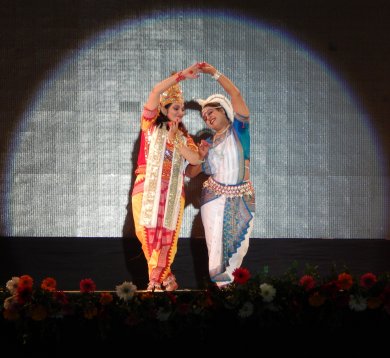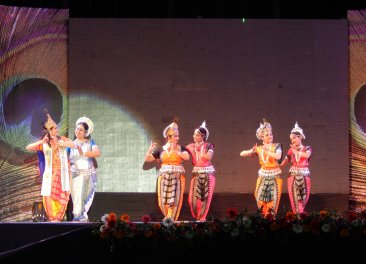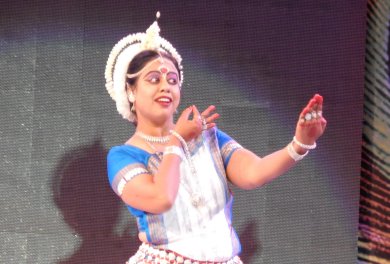
|   |

|   |
Love conquers the terror of death - Dr. S D Desai e-mail: sureshmrudula@gmail.com July 15, 2014 In the course of your exposure to art sometimes you find something touching you within and it becomes a flitting extrasensory experience along your life’s journey. The power of the eminent Oriya poet Ramakant Rath’s poetry in Sri Radha gets felt from time to time when Suprava Mishra in slow motion emotes in Odissi dance style to an expressive recital of the poet’s lines in the 90-minute dance drama she has choreographed. It was presented last January in Dwarka with the poem in Gujarati, now the other day for IIM’s Heritage Club in Ahmedabad in Hindi.  This poet’s Radha belongs to eternal time and sees Krishna as one having eternal existence. The dance drama opens on the lines of the last of the 61poems of Sri Radha. On hearing of Krishna’s death, Radha says, “The vermillion on my forehead now / Looks redder and redder.” “I will dress as the bride,” she says. The relation of those worldly ends, ‘the deluge of my pleasure’ is unending. “I could not have you,” she says, “If you did not die for them.” ‘Love conquers the terror of death,’ the poet believes. He has lifted Radha from the context of a mundane existence and, melting her physical shape, turned her into a metaphor for love. The dance drama opens on this Oriya song with Suprava as Radha essaying interpretation of each line with its bhava, both earthy and mystically ethereal at the same time, in her Odissi vocabulary. Flashbacks follow in subsequent segments. Specific incidents turn general in ‘We saw numerous assassins coming / One after the other …’ (Reference to Kans and Putana). With the vocalist Saswati and dancer Suprava’s identification with the bhavas and the shringara rasa they produce, Jayadeva’s Sakhi he keshi mathana mudaram from Gita Govindam leaves quite an impact. Then Radha-Madhava bheta bhai for the ‘nauka vihar’ song is followed by sequences of Krishna’s birth in Haveli Sangeet and the Maha Raasa with the gopis in Bhairavi. The segments with Suprava’s solos anchor the narrative and the theme. The languid body movement and the bhangis characteristic of Odissi, with appropriate lights, enhance Radha’s longing and the feminine charm associated with it. What a discerning rasika misses are the fine lyrical expressions the dancer’s visage could have conjured up. This is almost made up by Falguni Hiren’s intense and stirring enunciation in her controlled verbal recitation of the lines the dance movements are keyed to. The threefold music – Oriya, Hindustani and Haveli – create the right ambience. Vikas Parikh’s vocal contributions and Kirit Rajpara’s compositions get felt. 

The sequences are not in chronological order. The choreographer has perceived them as sequences in Radha’s dreamlike recall on hearing of Krishna’s death. Young students of Suprava’s Om Academy, including Archita as Krishna, still learning the basics of Odissi, are in the group choreography with appreciable zest and involvement. The poet has said it that he felt someone had dictated a few lines of Sri Radha to him. Suprava echoes his sentiment and says, “Sometimes I felt I was Radha and had tears in my eyes.” Dr. SD Desai, a professor of English, has been a Performing Arts Critic for many years. Among the dance journals he has contributed to are Narthaki, Sruti, Nartanam and Attendance. He guest-edited Attendance 2013 Special Issue. His books have been published by Gujarat Sahitya Academy, Oxford University Press and Rupa. After 30 years with a national English daily, he is now a freelance art writer. |